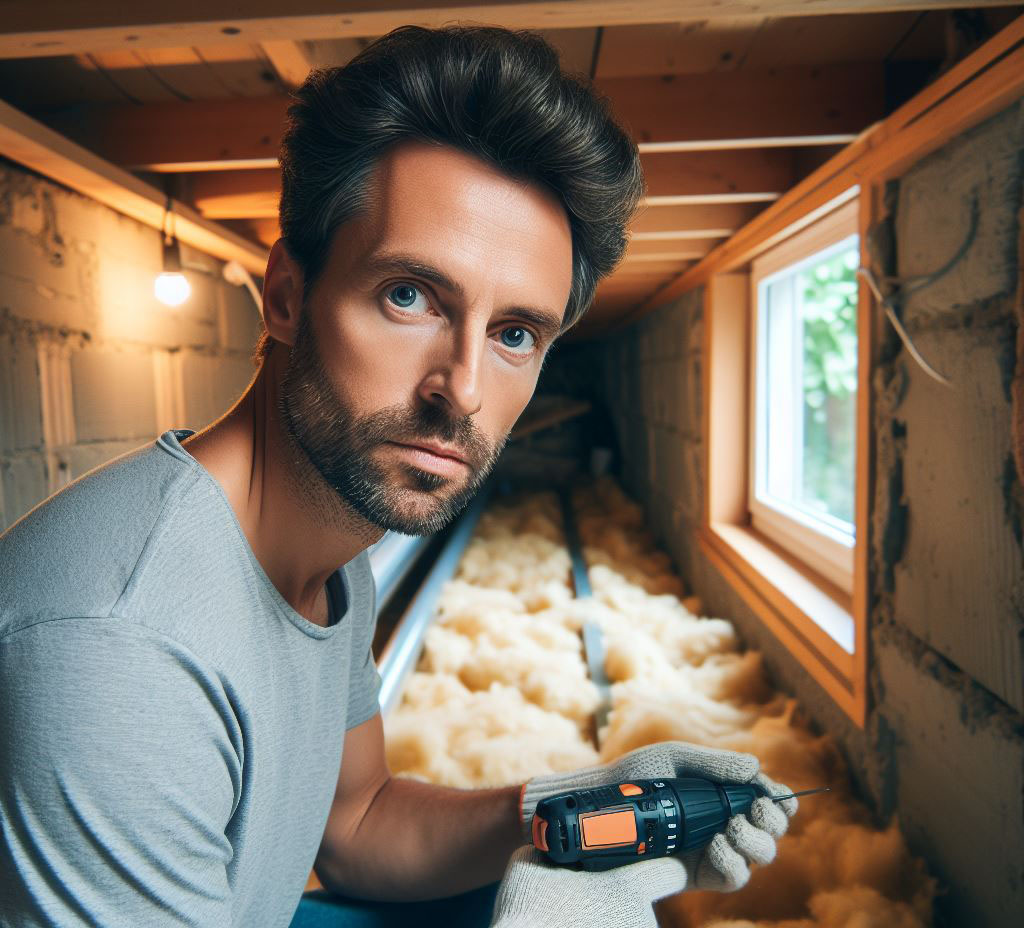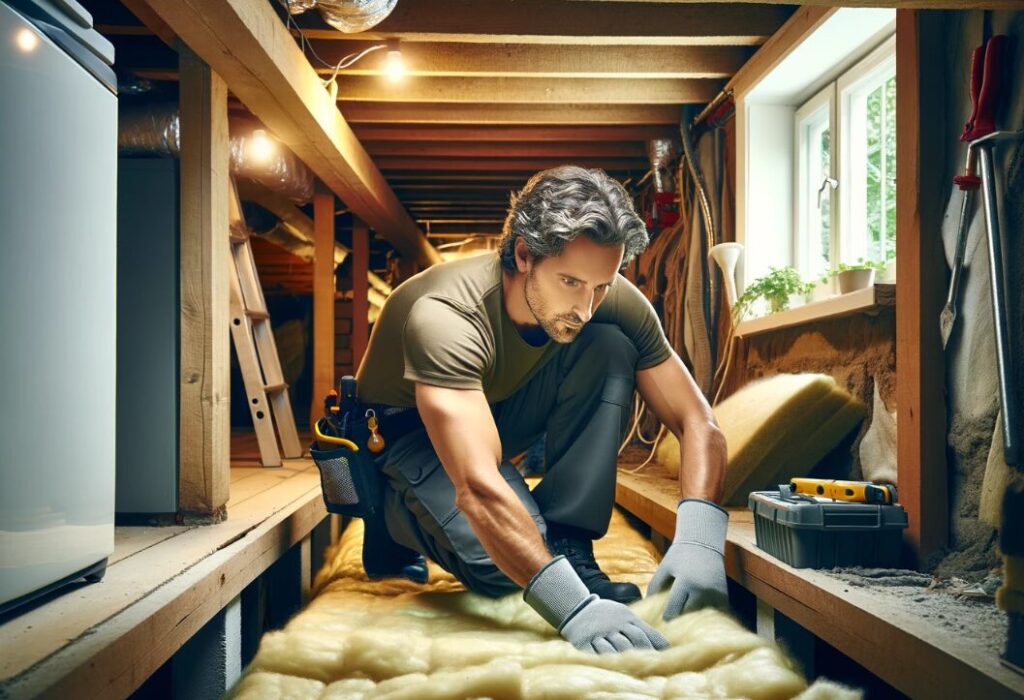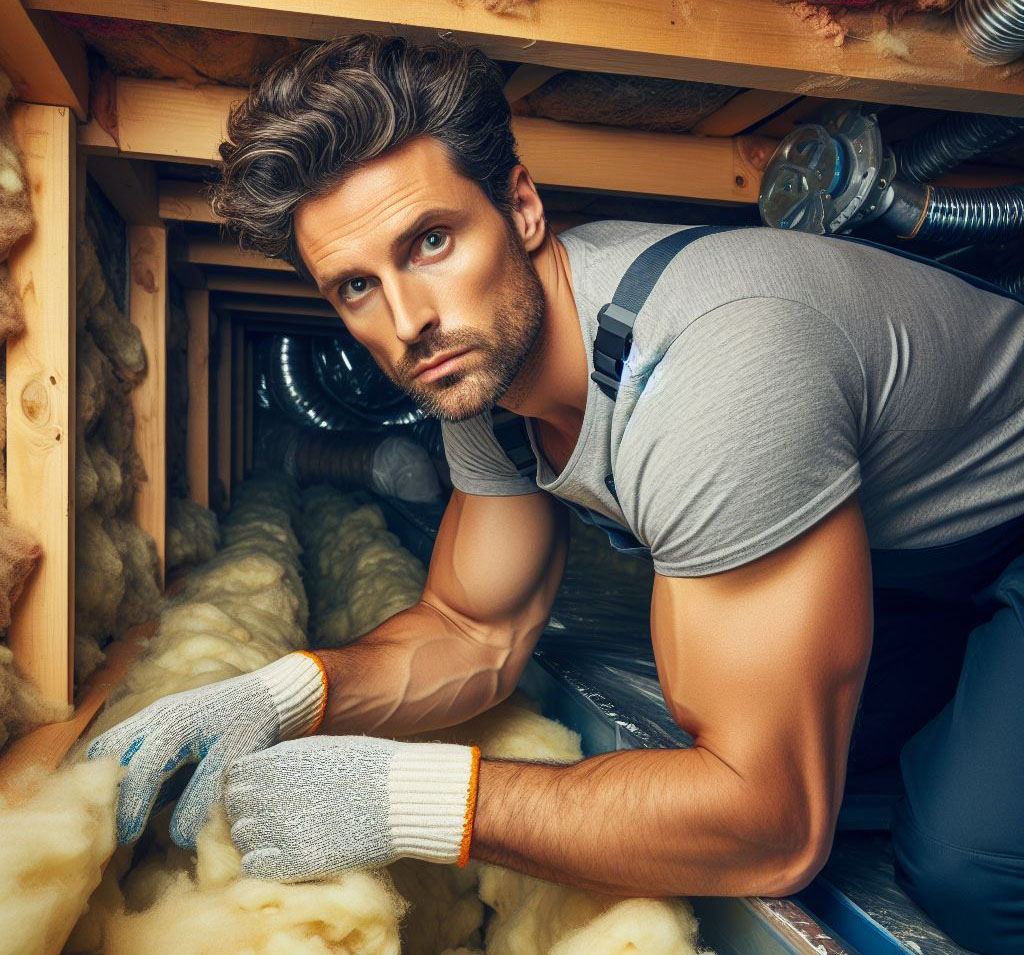In the world of home renovation, insulating your crawl space is akin to laying a firm, protective foundation for your home’s comfort and energy efficiency. It’s an investment in the longevity and livability of your space. Proper insulation shields your home from the extremes of the seasons, maintains a stable indoor climate, and, crucially, keeps your energy bills in check. This isn’t just about comfort—it’s about creating a harmonious living space that’s efficient and cost-effective.

Understanding Crawl Spaces
Crawl spaces, often overlooked, play a pivotal role in the structural integrity and environmental control of your home. They are the narrow, uninviting voids under your home, crucial for ventilation and as a buffer against ground moisture. However, they come with their own set of challenges:
- Role in Construction: These spaces are more than just structural voids, they are designed to promote airflow, which helps to regulate temperature and moisture levels beneath your home. They also provide convenient access for repairing and maintaining essential home systems.
- Common Issues: Despite their benefits, crawl spaces are notorious for their susceptibility to moisture accumulation, pest infestation, and energy loss. These issues, if left unaddressed, can lead to more significant structural problems, unhealthy living conditions, and inflated utility bills.
Pre-Insulation Considerations
Jumping into insulation without proper preparation is like painting over a damp wall—the issues will resurface. Address these critical steps first:
- Inspection is Key: Approach this phase with the meticulousness of a detective. Scrutinize every corner for signs of moisture, mold, or structural anomalies. This step is not just about laying insulation, it’s about ensuring the health of your home from the ground up.
- Clean House (or Crawl Space): Clearing the crawl space is essential. It’s the preparatory step that sets the stage for effective insulation. Address any signs of moisture—you’re not just insulating, you’re also sealing your home against dampness and potential water damage.
- DIY or Call the Pros?: This decision hinges on your skills, comfort level, and the complexity of the task at hand. While the DIY route can be cost-effective, don’t underestimate the intricacies of the job. A professional’s expertise can often be the difference between a job done and a job well done.
Approach crawl space insulation as a critical investment in your home’s health and efficiency. Done right, it’s a project that pays dividends in comfort, savings, and peace of mind for years to come. With meticulous planning and execution, your crawl space can transform from a problem area to a cornerstone of your home’s stability and energy efficiency.

Types of Crawl Space Insulation
In the realm of crawl space insulation, the materials you choose are as crucial as the craftsmanship with which they are installed. Let’s delve into the most commonly employed materials, weighing their strengths against their weaknesses:
- Fiberglass Insulation: This ubiquitous material, often found in batts or rolls, is a go-to for many due to its cost-effectiveness and accessibility.
- Pros: It’s budget-friendly and readily available, making it a popular choice for those looking to insulate on their own. Its installation process is relatively straightforward for those familiar with its nuances.
- Cons: Its Achilles’ heel is moisture. Once wet, its insulating capabilities plummet. Additionally, its fibers can be irksome and hazardous, necessitating protective gear during installation.
- Foam Board Insulation: This rigid option offers a modern approach to insulation, with its impressive thermal resistance and moisture resistance.
- Pros: It excels in preventing heat transfer and stands up well against moisture, making it a robust choice for spaces prone to dampness. Its slim profile is also advantageous in spaces where every inch counts.
- Cons: The cost can be a deterrent, and its installation demands precision and care, often making it a job for seasoned hands or professionals.
- Spray Foam Insulation: For a comprehensive seal and top-tier insulation, spray foam stands out, adeptly filling gaps and creating an airtight barrier.
- Pros: Its ability to expand and fill even the most elusive spaces makes it unparalleled in sealing and insulating. It’s an all-in-one solution for insulation and air sealing.
- Cons: The cost can be substantial, and the application requires professional expertise, making it less accessible for the average DIY enthusiast.
Recommendations for specific climates and conditions:
- In areas grappling with high humidity or frequent dampness, fiberglass might falter, while foam board and spray foam stand resilient.
- In confined spaces, spray foam’s ability to expand and conform makes it an unmatched ally.
- For those balancing a tight budget with insulation needs, fiberglass offers a cost-effective solution, provided the space remains dry and well-ventilated.

Step-by-Step Guide to Insulating a Crawl Space
1. Measuring and Material Selection
Embarking on the insulation journey begins with meticulous measurement. Arm yourself with a tape measure and navigate the entirety of your crawl space. Record dimensions with precision—this is the blueprint for your insulation endeavor.
With measurements in hand, select the insulation that aligns with your crawl space’s needs and your climate’s demands. This decision is the cornerstone of your insulation project.
2. Preparation and Safety
Prioritize your safety with appropriate gear: safety glasses to shield your eyes, gloves to protect your hands, and a respirator to guard against airborne irritants.
Prepare your workspace by ensuring it’s devoid of debris or remnants of old insulation. A clean slate is paramount. Ventilation is equally vital, a well-ventilated workspace is a safe workspace.
3. Installation Process
- Crawl Space Wall Insulation: Begin with the walls. For foam board, tailor each piece to fit and secure it steadfastly with adhesive or specialized fasteners. For fiberglass, nestle it between joists, ensuring the paper facing is oriented correctly to create an effective vapor barrier.
- Insulating the Crawl Space Floor: Elevating your insulation efforts to the floor can augment your home’s thermal envelope. Unfurl the insulation between joists, fastening it securely to prevent sagging or displacement.
- Sealing and Insulating Crawl Space Vents and Access Doors: Finalize your project by turning your attention to vents and access doors. These are potential weak points in your insulation armor. Employ foam board or spray foam to seal these areas meticulously, ensuring your crawl space is enveloped in a continuous, unbroken layer of insulation.
Ensuring Effective Insulation
Proper insulation is not just a matter of filling spaces, it’s about creating a harmonious environment that speaks to the needs of your home. Let’s delve into the essentials:
- Vapor Barriers: Consider these the shield against the relentless siege of moisture. These barriers are paramount in preserving the integrity of your space, warding off the insidious spread of mold and wood rot. When installing, ensure they’re meticulously placed to cover every square inch, particularly if you’re contending with a dirt floor.
- Sealing Air Leaks and Thermal Bridges: An unsealed crawl space is akin to leaving your front door open in the middle of winter. Employ caulking or foam sealant to fortify your fortress against the invisible enemy—air leakage. Likewise, address thermal bridges with precision, as these structural elements can unwittingly undermine your insulation efforts by conducting unwanted heat flow.
- Insulation Thickness and R-values: The effectiveness of insulation is not merely a factor of its presence but of its appropriateness to the task at hand. Consult local building codes to ensure your insulation meets the recommended R-values, thereby optimizing your home’s energy consumption and comfort.
Maintenance and Upkeep
Insulation, much like any component of your home, requires vigilance and attention to maintain its function and efficiency:
- Routine Inspection: An annual examination of your crawl space is a small investment that can prevent larger expenditures down the road. Keep an eye out for any signs of sagging insulation, pest activity, or moisture intrusion. Early detection is the key to simple, cost-effective solutions.
- Signs of Trouble: If you notice a spike in your energy costs, experience drafts, or detect a persistent musty odor, these may be indicators that your insulation is compromised. Address these warning signs promptly to maintain the health and comfort of your home.
FAQ Section
The signs can be subtle but telling. If your heating or cooling system seems to labor more than it should, or if the floors above the crawl space are perpetually cold, these are your home’s way of signaling a need for insulation. Additionally, visible moisture or mold in the crawl space is a clear call to action.
The optimal insulation material depends on the unique characteristics of your crawl space and the climate you reside in. While fiberglass is cost-effective and widely used, its susceptibility to moisture may render it less effective in damp conditions. Foam board and spray foam, though more costly, offer superior moisture resistance and can be particularly effective in confined spaces.
This decision hinges on your level of comfort and expertise with home renovation projects. For those well-versed in DIY tasks and comfortable working in confined spaces, insulating a crawl space can be a manageable project. However, if you have reservations about the complexity of the task or the conditions of your crawl space, seeking professional assistance ensures that the job is executed accurately and safely.
The lifespan of insulation varies based on the material and the conditions in your crawl space. Conducting a yearly inspection can help you gauge the health of your insulation and identify any issues before they escalate. Timely maintenance or replacement can significantly extend the life of your insulation and enhance the overall efficiency of your home.
